| D*Face Interview |
| Wednesday, 07 May 2008, 11:52am |
 Taking his 80s skate influences, combined with wicked bold character illustration and plenty of clever punk rock irony D*Face has developed an artist style and street art system that is all his own. Taking his 80s skate influences, combined with wicked bold character illustration and plenty of clever punk rock irony D*Face has developed an artist style and street art system that is all his own. Not long ago I was able to catch up with D*Face and his right hand man, WordtoMother in New York City. I was pretty impressed to find that a guy who grew up in London was as influenced by 80s American skate culture as many of us were in the states. Taking his 80s skate influences, combined with wicked bold character illustration and plenty of clever punk rock irony D*Face has developed an artist style and street art system that is all his own. One thing we can all be sure of, D*Face will always be the guy to get the last laugh. - Manuel Bello 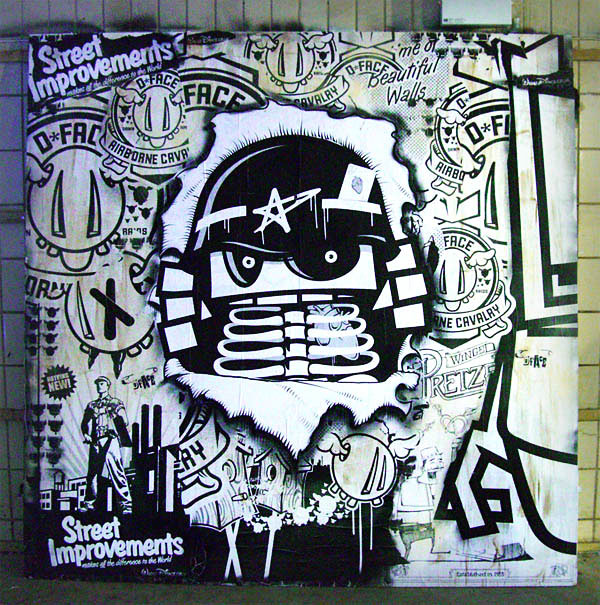 Manuel: What is D*face exactly? D*Face: D*Face is a secret government project, started about 10 years ago to test the publics awareness and resistance when faced with an alternative to the mundane advertising that surrounds our public domain. There is no specific goal, conclusion or end it merely serves to test cause and reaction. 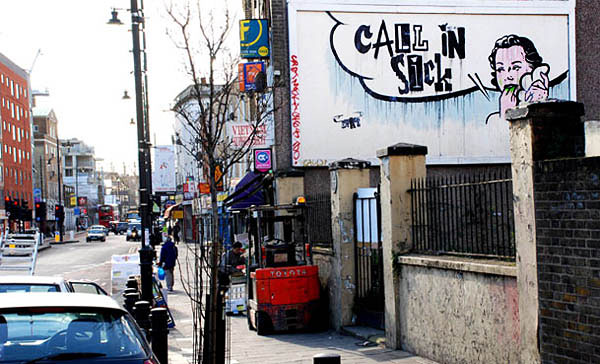 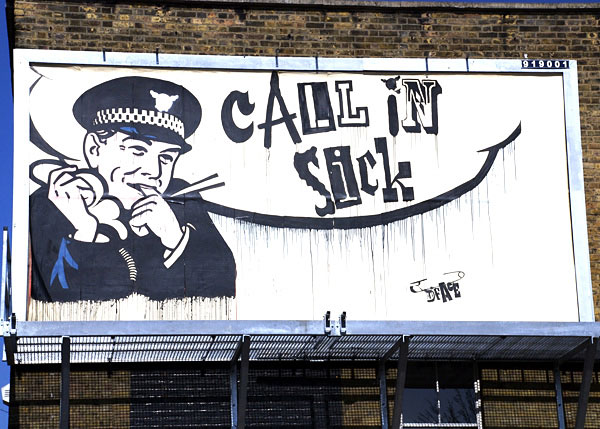 Manuel: Where did you spend your childhood and what was your upbringing like? D*Face: I was raised in London, born and bread to hard working parents. Mum worked in a bank, Dad worked as a panel beater and bodywork sprayer. I hated school. I had a very clever sister who was the academic one. I was never going to step to that so I decided to just sorta find my own direction. I started to get really into graffiti at a young age. My Mum stupidly bought me the book 'Spraycan Art' that pretty much changed my life. I used to draw and doodle and things like that and tried to be a graff artist as a kid, but I did not really get the full idea of it. At that time it was an American thing for the most part. I mean I would see it around, but I did not fully understand the culture of it in those days. I was too young I guess. Then as I got a little bit older I got into skateboarding and that was pretty much the center of my life. Skateboarding changed my life. 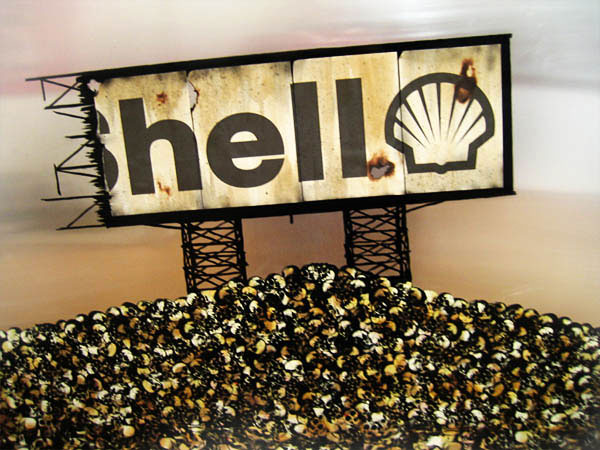 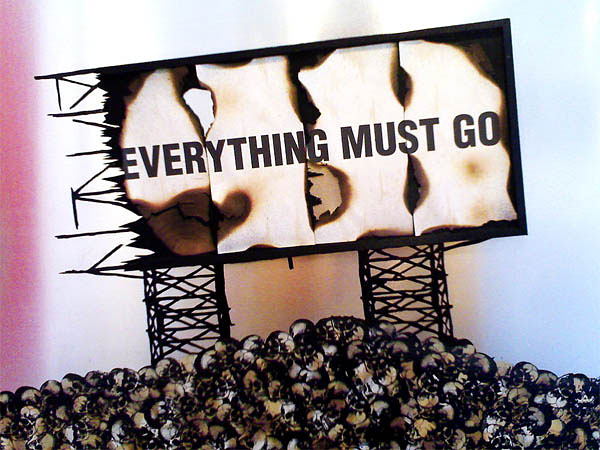 Manuel: Who were some of your early skate influences? D*Face: I was actually talking about this the other night. When I was about 12 years old I saw Back to the Future and it had Per Welinder doing the skating. That was pretty inspiring back then. Apart from magazines there was not really any of that American culture coming in to the UK except for that film. I was like I need to get a wide skateboard because at the time I had some skinny plastic thing that I had since I was 5. I kept busy skating around on it because back then that was what skateboarding was: skinny boards. But before long I needed to get me a real skateboard, we didn't have any money so it was a big deal to go and get a new skateboard. I remember looking up at the walls in the one skate shop in London and it was a Ray Meyers Santa Cruz. It had the art of Jim Philips gracing the bottom. I was looking up at it and thinking that is the most amazing thing I have ever seen. I loved that board but it was a freestyle board and expensive. My mum didn't have the money to buy it so I ended up getting the 'house' board. It was like a Zig Zag or something. It was fucking terrible, Variflex wheels and trucks. But it started it all! Going back to the original question I guess my first influence was the Ray Meyers board because of the graphics. I guess it was a combination of skate culture, punk music and the art of Jim Philips that really got me into skateboarding and into the illustration side of skateboarding. Of course I didn't even know him as Jim Philips, except by his art until many years later. 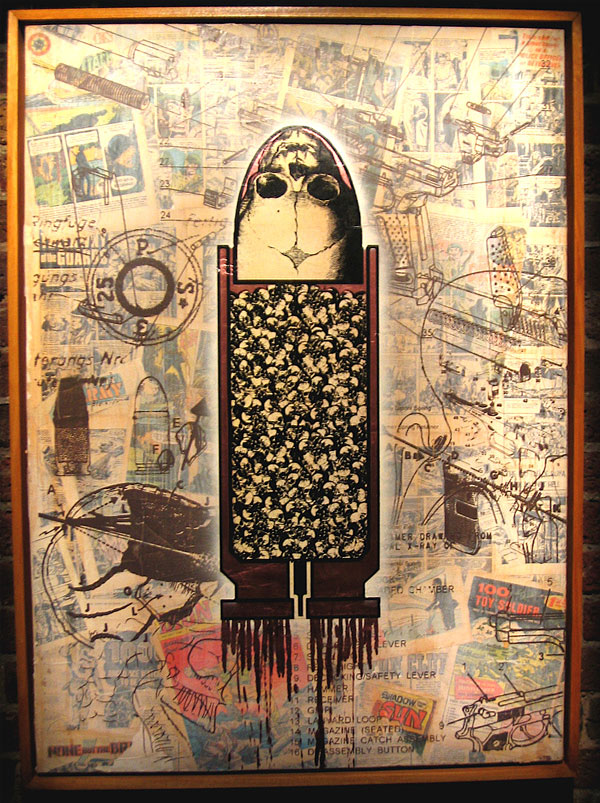 Manuel: You mentioned Per Welinder. I actually saw Per at a mall in Santa Fe, NM in 1989 and after the demo (with the one launch ramp set up in the parking lot) me and a couple of my friends poached it, just so we could say we hit the ramp that he hit. D*Face: Yeah, the Powell team came over to Europe and back then it was all about Powell Peralta. They all came over, Cab, and Tony Hawk and all of them. We went to one of the very few skate spots in London called Latimer Road, which had a pretty decent half pipe for the time and we had never seen anything like it. Those times were amazing for sure. 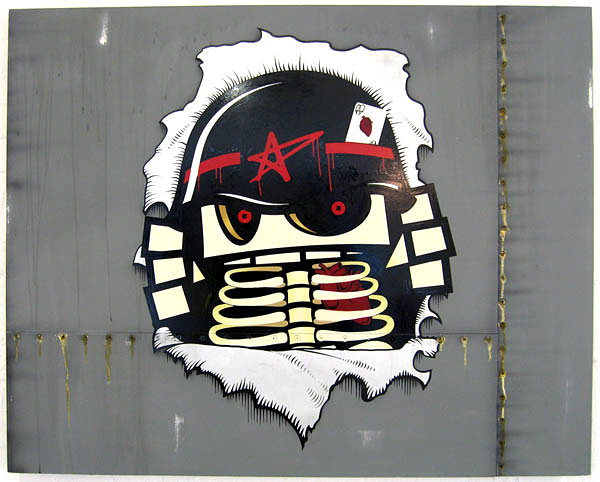 Manuel: How did you get into illustration work? D*Face: After I managed to get myself through school, failing all of the 'academic' subjects, due to skating, graffiti and generally fucking around, I somehow managed to get into a college for photography. But again, I just got stoned and fucked around for a couple years and realized I was never going to be a professional photographer. My mum was like 'well, I'll get you a job at the bank', my dad was like 'I'll get you a job as a mechanic' and I was thinking what the hell are the two of you talking about. I wanted to be a student, and bum around for a few more years. I was looking into this animation and illustration program, totally expecting not to get in. Luckily I got an interview and had this tutor that was totally into the same stuff as me and gave me a place on the spot. That one guy changed the direction I was going. Once I started that coarse I realized that all these magazines like Thrasher, with Jim Philips art and punk music and skateboard culture, was something that you could do with your life and make a living at it. There was this moment when everything I had been into in my past locked and all the suddenly made sense. If I was not doing this God knows what I would be doing. 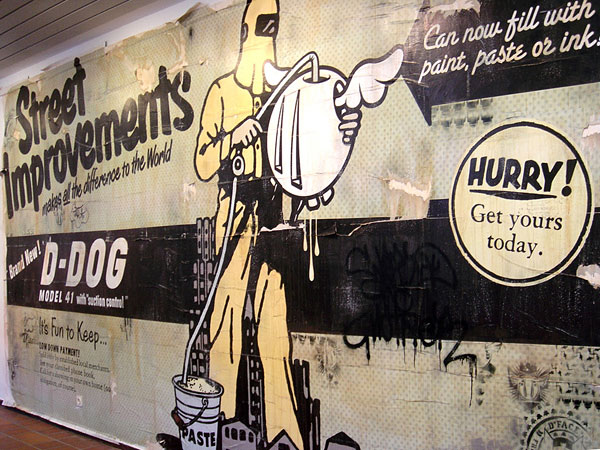 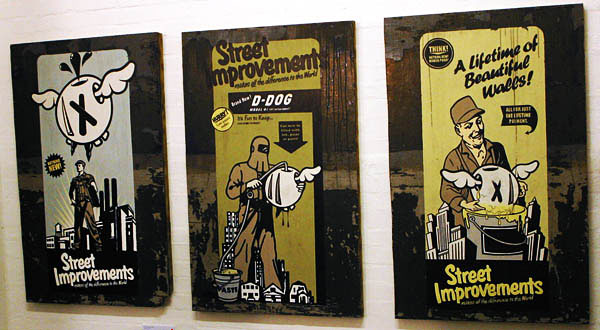 Manuel: How would you personally describe your art and the underlining theme behind it and how did the street thing all begin for you? D*Face: Originally it started out as a creative release because I was really bored with what I was doing. I had spent all this time and worked really hard to be able to work within the (graphic arts) industry and thought it was all going to be creatively great. As it turned out it wasn't the case at all, at least not the situation I was in back then. On my off time or between jobs I would draw little characters. It really started out as something I was just doing to fulfill a creative release. Anywhere I would go I would put up these stickers and just try to cover as much of London as I could. It kind of became a subversive intermission to all the shit that was around us. But I was never really aware of it. I was just putting my shit up wherever I went!! Then a couple years later the whole sticker scene really took off in London. I went to this art book opening and there was a bunch of people milling around. Up to this point I was just doing my own thing, taking my stickers and printing out bigger versions on paper and putting them up. Then I show up at this book launch and these guys were like "fuckin-eh, you did that shit", I was like "um yeah, you have seen it?" And these guys were like "fuck yeah, it is everywhere!" The only person I had been out with at that time was Shepard. We kept in touch and when he would come over we would put some stuff up. Until that point it did not even occur to me to put my work up to get people to notice it. It was more escaping the everyday and to get people to question their environment and culture. Question the advertising that is around them. It is a little different now, the more aware the public becomes of street art the less applicable it seems to be. Because it was like "oh thats D*Face" or "Shepard" or whoever, instead of what is the meaning behind that. 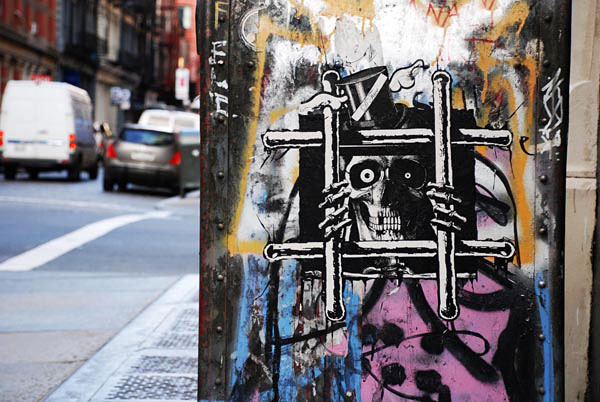 Manuel: I can see that being true. I remember the stuff in Pictoplasma, from the first books the shit that really stood out to me was your stuff and The London Police. D*Face: Yeah that is really cool, I have known Chaz from The London Police since way back. Not since the get go, but they were the only real crew that was also doing character stuff of that type at the time. In the same methods that I was using, although at that point I was doing paste-ups and they were on the drawing direct on the blank advertising posters. There was one other group of guys doing stuff called the Toasters. They would go around pasting toasters. They stopped and laid low for a long time but actually recently just had a show. Then there was Shepard who came over in 99' but his stuff was nothing like what we were doing. 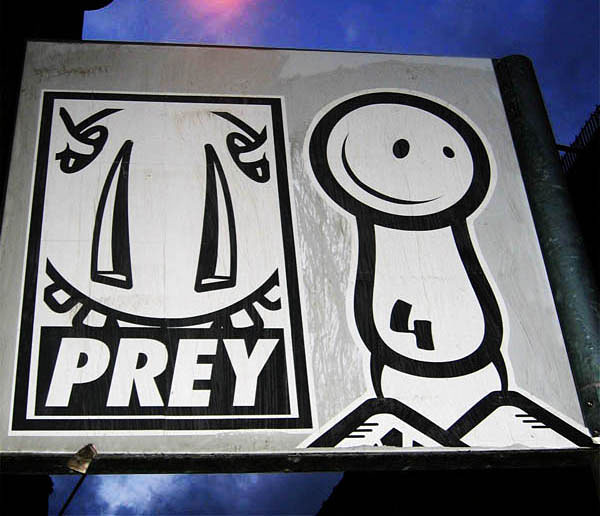 Manuel: Can you explain some of the symbolism in your work? D*Face: Well there are different types of symbolism. Like with the CliChé piece. It is really quite cliché because that image of Che has really become such a door matt graphic. These people wear it as a symbol of them being some kind of revolutionary. They don't seem to understand they are wearing it as a tee shirt, as a product, which is so far removed from his beliefs. I also love the idea of him coming back from the grave to kinda question what all of this consumerism is about. Same with images of Marilyn, who was probably the first iconic super model ever. Then there is Andy Warhol who was the artist to really use the media as a tool. So, combing those things I hope to make society question their fascination and fixation with fame and celebrity. 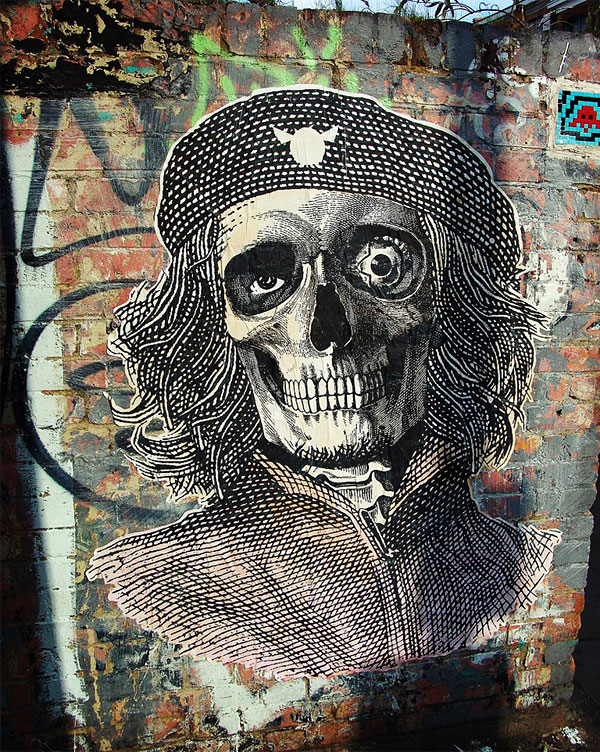 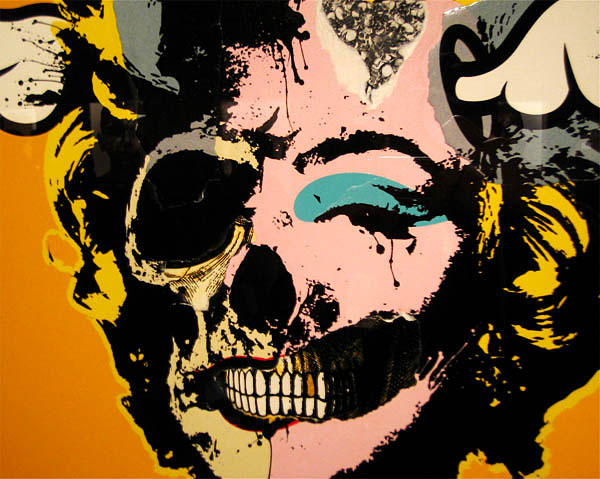 Manuel: For your Death and Glory show you did the huge metal D*Dog smashing car piece, what was involved in creating that massive sculpture and do you have any more large projects lined up? D*Face: This now friend of mine named Ben Johnson who was doing big sculpture work had come down to Stolen Space one day. We started talking and he said: "It would be great to work with you, would you be interested in putting something together?" I was like yeah that would be sick. He suggested doing one of my characters but I was not that into it because I had been doing smaller version of them already for years. I told him I would be interested in doing something bigger with some other meaning. Then some time later I had this show planned and I really wanted to do something grand and massive. I thought it would be cool to take something that started as a sticker, that has taking pretty much every path it could have possibly taken and just take it one step further. I did not really have any money for the project aside from a couple thousand pounds from a sponsor, but luckily he was a really cool guy about it and it all worked out. We rented a space that was big enough to hold this thing. We worked on it straight for three months. It was a really tense the last 2 weeks trying to get that shit put together. It turned up the morning of the opening to be completely unpainted. I was like "Fuck, we have a lot to do", but we got it done. Working with Ben was really great, he completely understood me and the way I work, and the kind of finish I needed to achieve. We were planning on doing a fiberglass cast of the original and then taking them around and doing various street installations, leave mobile version in the street so we could see what happens to them but didn't since we never sold the original, which was not surprising to either one of us. We do have another massive something planned for later this year. 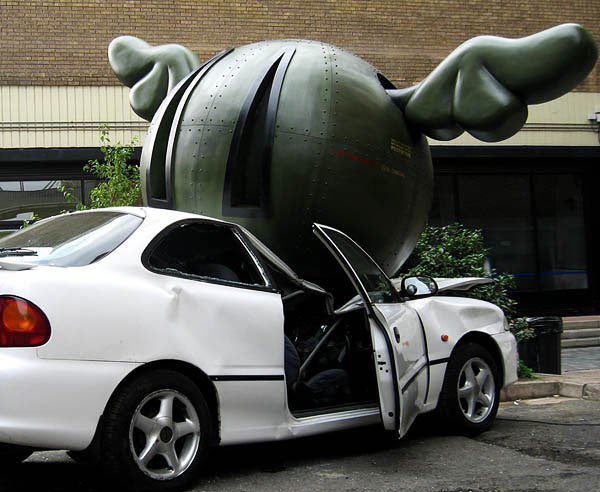 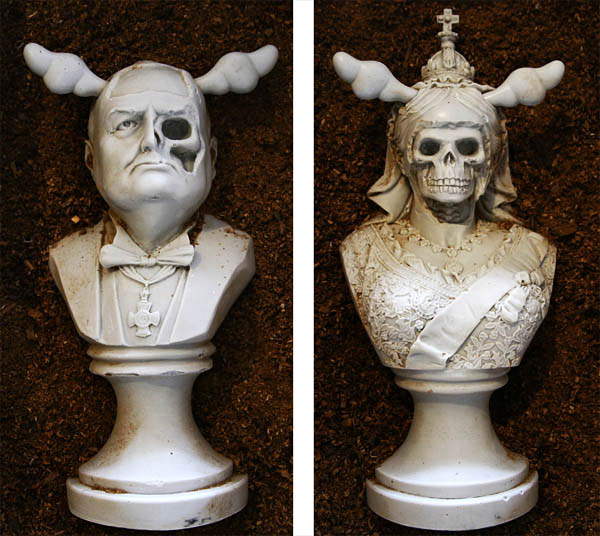 Manuel: How much other street work are you doing these days? D*Face: A lot less than I would like to be doing and a lot less than I have done in the past. It is always a difficult thing. I mean my heart lies in the street. That is where I come from and how this whole thing has come about. It is a slightly different feeling with a gallery show. Obviously, if I am doing a show in a gallery I want to at least succeed with it and put as much into it as possible. I also had a kid last year, so my weekends are spent with my family. Evenings I am trying to get home at a reasonable hour, which does not always happen, as I am sure you can understand. We do a lot of street work when we travel. Did a bunch of stuff in Norway and try to do as much as we can when we come to New York. Not as much stuff as I would have liked but New York can be a difficult place to put stuff up these days. 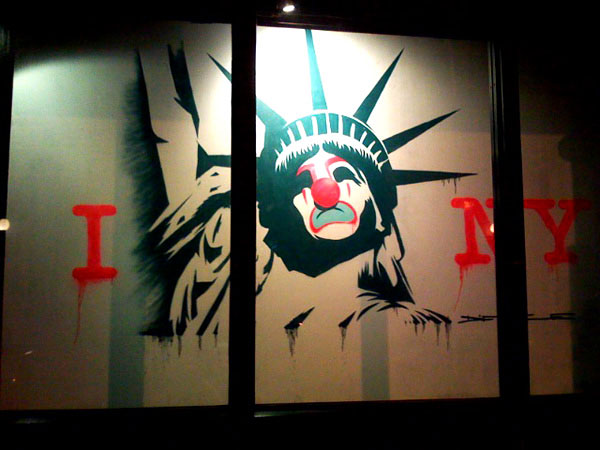 Wordtomother: Plus this time around there were a few problems with our shit getting through customs. It does not make it easy. There were a few hindrances this trip. 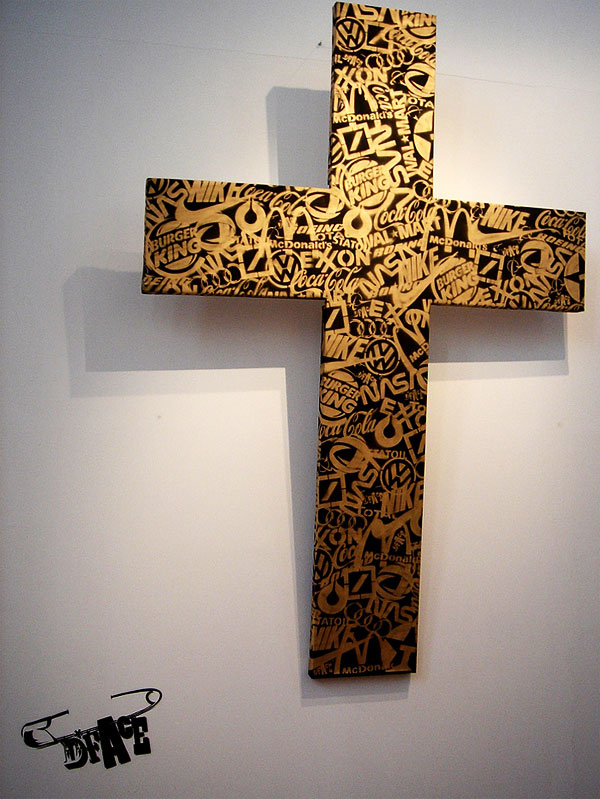 D*Face: We are coming back later this year. We plan to do some stuff then. The thing about New York is, it is a different city than London. I have come out here with Shepard and just put up loads of shit in one or two nights. Times have changed, New York is aware of it now and it makes it difficult. When you are spending a few days here preparing for a show or whatever, do you want to risk of spending a couple nights in jail? 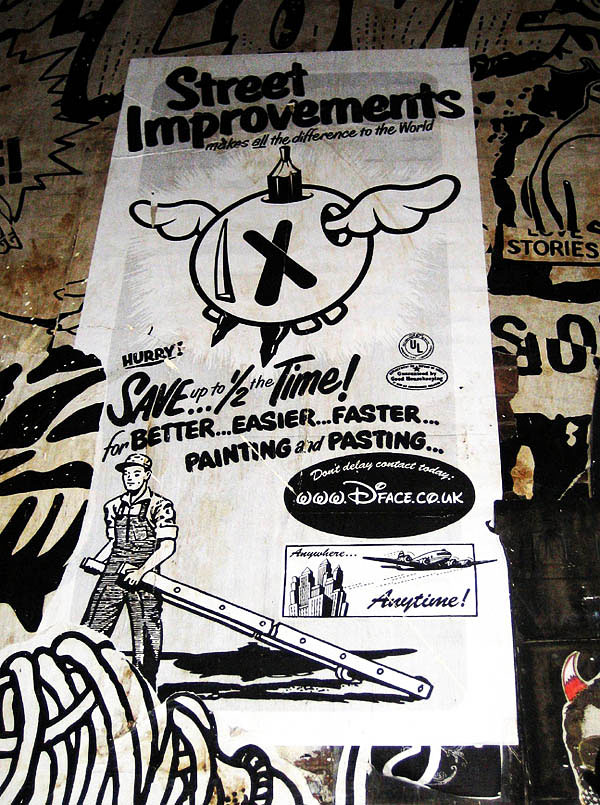 Manuel: New York has definitely become overly saturated with street artist. Every Tom, Dick and Harry is slapping shit up whether it is good or not. Do you feel like it is the same in London? D*Face: There was a period of time that that was the case. We are in 2008 now aren't we... I guess it was 2005 or maybe 2004 that every fucker seemed to have a sticker or thought they were a street artist and it got to the point where I was finding myself a little pissed off about it. I guess I was feeling a bit stifled in all of it. Lets face it, you can not really make any kind of impact when there is a million others doing the same shit that you are doing. At the same time I have always had this view that if it is "street" art than I should support it. Anyone who goes and makes their art public, then great. There is no gallery critic saying this one is good or this one is bad. It is freedom of speech and that is what makes it such an amazing thing to go out and do. I just think that people who are going out and doing it should be doing what they do, rather than what others are already doing. The alternative is there are all these kids looking at what has already been done and in the end you end up with a thousand of Banksys. 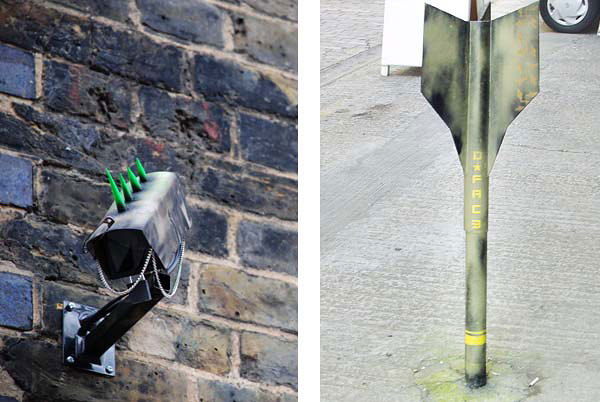 Wordtomother: I must say in London it does seem to be a lot more garbage out there than in the past. Just a few years back it was not about anything but the love of it. Now it seems that there is some recognition coming into play with all this and people have began to come up with these other motives. People are seeing some of the bigger guys in the scene getting gallery shows from it and they will put up a piece of paper or a few stickers somewhere and that will be it. I don't think that many of these kids get the scale of it and it is more than just that. 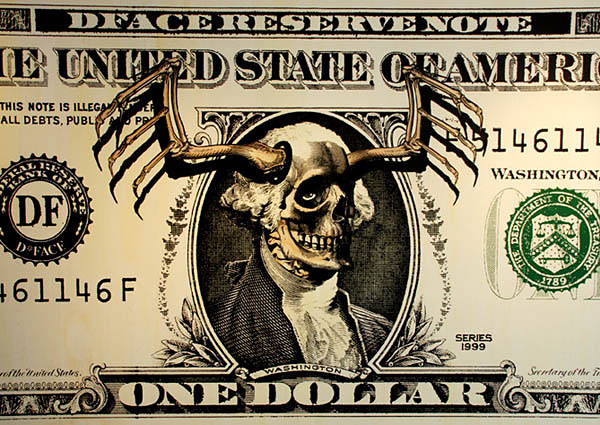 D*Face: That is another thing, there are other guys who have been around for five minutes getting gallery shows and selling their work for crazy money, especially in the UK. I think that the art scene is the same as any. You have to pay your dues. There is this factor that has become less about the street art and more about the street aesthetics. You may have drippy tags in you work but you might have never done a drippy tag in your life. I think that people are starting to feed from that and it is sneaking its way into contemporary art culture. They're not street artists but they are representing themselves as that. Half the time I also find myself questioning what people's motivations are. 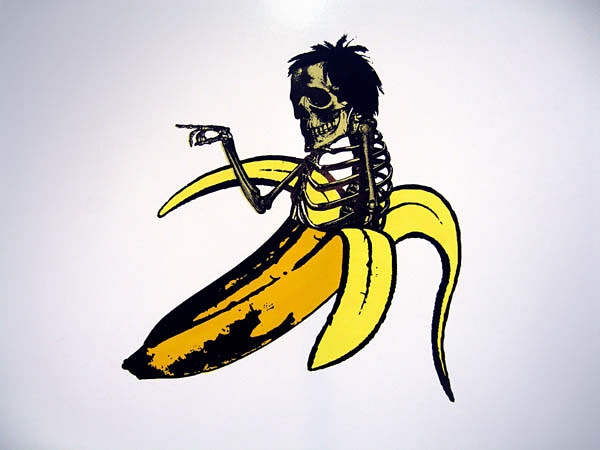 Manuel: Do you think that the European street scene is more of a form of expressionism? D*Face: I do think that in the UK people are a little bit more receptive to that. Just from people who I have spoken to here in the States. Like WK for example, I had seen a massive amount of his work up in New York but have not heard a whole lot about it. I wonder if it would have been better received in Europe. No mater how you look at it, he did it with the imagery and message that he thought needed to be out there, that alone says a lot. As a whole I think there is more of a social or political comment that is being made in Europe or at least in the UK. I'm not saying that artist in the States don't have social or political agendas. I just think that in the UK that is something that is more evident. There are those in the States however who are getting a message across without question. 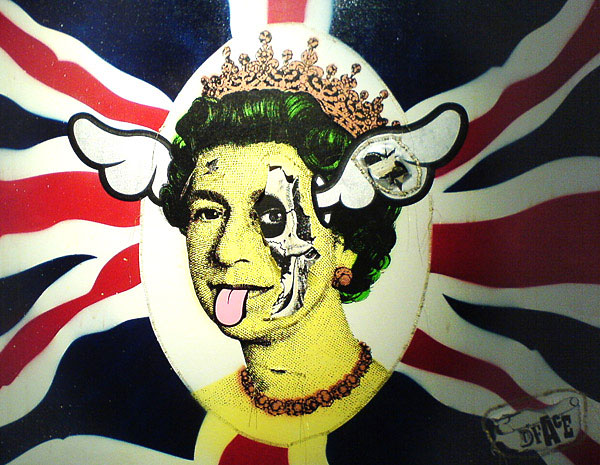 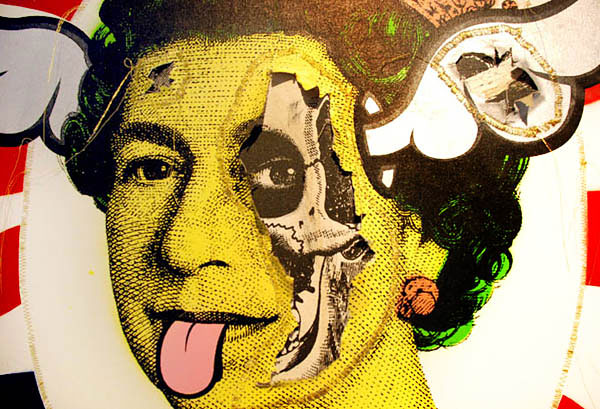 Manuel: Where do you see this movement in 10 to 20 years, do you think your work will find its way to some more established art museums? D*Face: If it does or it doesn't, it really does not matter. I would like to think that at some point the street scene will be given the recognition it deserves. I would like to think that it will be hung in the right places. It is really difficult to think of some of it hung in some of these museums. They just seem so... formal. The way all of this street art has come about is so informal. I think in order for street art to infiltrate some of these places there will have to be some key people who really do believe in the spirit of the art. All I can say is I was around before it was this big movement and I will be around if it disappears. If I have to support myself doing some other job than that's what I'll do, I've done it before and I'll do it again… but I hope it doesn't come to that!! 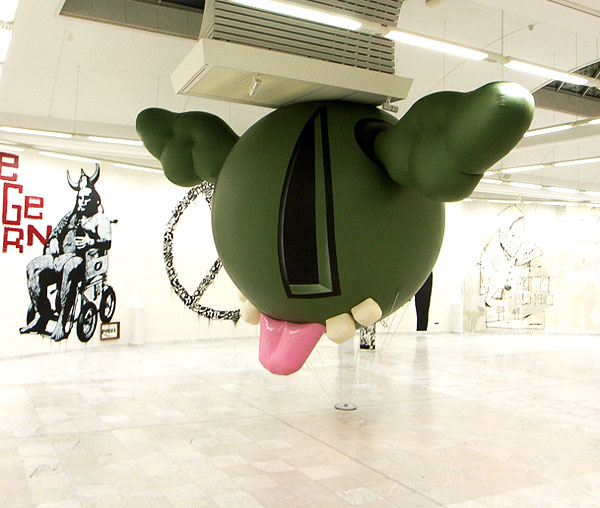 Manuel: I think this is an obvious question that you have probably already answered but do you prefer your art in the street or gallery? D*Face: I love doing work in the street but it is also nice to be creating gallery work as well. I think the two things can exist together. I obviously try to approach the things I do in the street differently than the way I approach work I'm doing for the gallery. 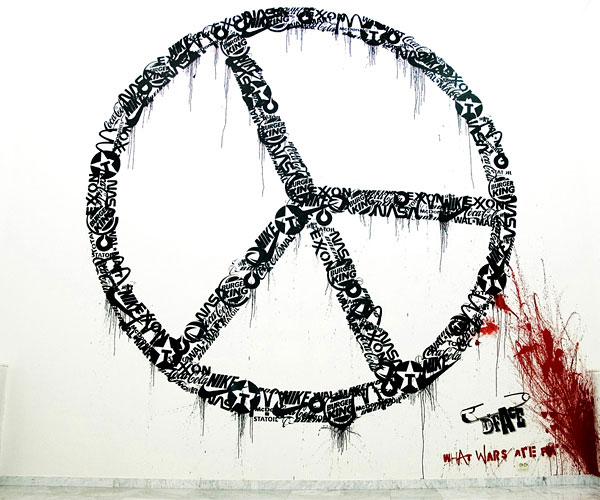 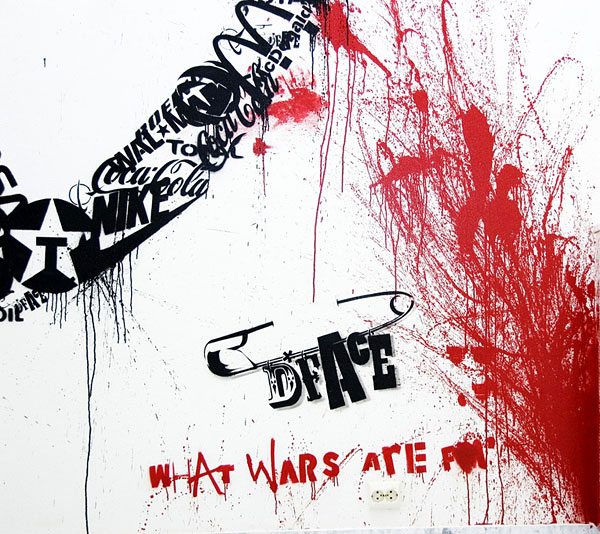 Wordtomother: Plus as an artist I think that type of approach gives you the freedom to go down both avenues. D*Face: It is true. I like to think of my work as going down a path of sorts. I hope that people get that and if they have been following it they can see that. I understand when people say I wish you would just keep doing more character stuff. I also understand people saying that they love the stuff I am doing now much more than what I was doing in the past. But I think it is important to have some repetition in your work in the same sense that can be a little bit stifling. There are also those other more personal reasons why my work has taken the path it has. The whole play with death comes from having some things in my life that were pretty tough and dark. 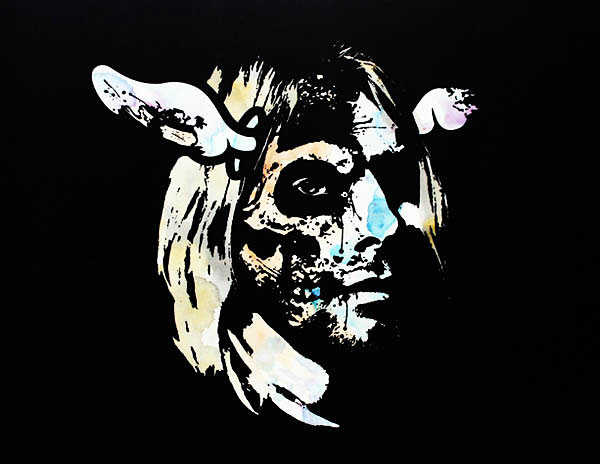 Manuel: There is also a very literal way of looking at those death pieces. D*Face: As I said, what I was trying to do with those pieces was question the whole idea of celebrity and fame. That is the one thing that we cannot deny is that we are all going to die. That is the point, to question the celebrity status of these people. But as soon as they die they almost become legends. There are those celebrities who people say if he or she would have died much younger it would be much better. Really, if you think about it, a lot of the true pop culture legends died at a young age. Is it the person that society is in love with or thought of what or who they are. There is pretty much an endless game you could play with that. 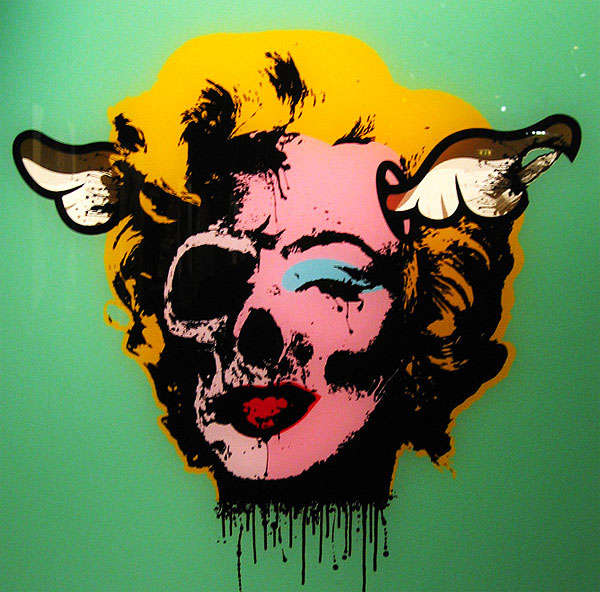 Manuel: Where does the merchandise and vinyl toy thing fall in to all this art stuff for you? D*Face: Ya know, that is a difficult thing. I was approached about doing the vinyl toy thing and at the time I was really stoked to do it. But what it looks like and what it ends up becoming are two totally different things. I wish now that I had never done it. I don't know that I would do it again unless I knew that it would be executed exactly the way I wanted it to be. The vinyl toy thing is something that everyone has jumped in. Like anything, there are maybe a handful of people whose shit will be worth what you paid for it down the road and in some cases more. I bought a few of the Kaws toys way back when, the Futura stuff, some James Jarvis and some of those became worth crazy money. But not long after that it was crazy money just to buy any of them, and everyone started to turn them out so quickly I finally had to say enough. Plus these toy people never take them out the packaging. Fuck that, if I'm paying good money for these things I want to take it out and feel that shit. 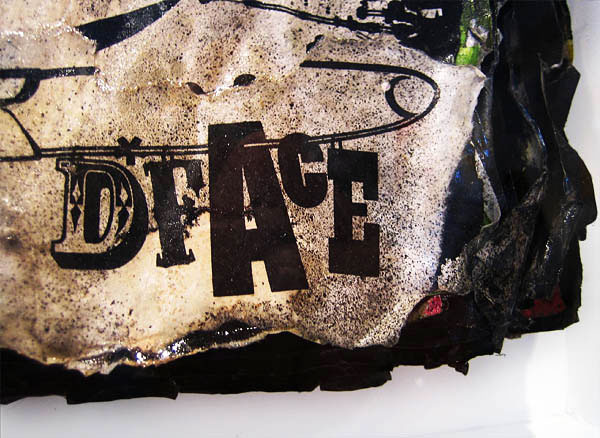 Manuel: Does D*Face Have any words of wisdom? Wordtomother: Stolen Space.com D*Face: (Laughs) The only thing I can really say is, do what you do from the heart and it will lead you in the right direction. Many thanks to: D*Face, Wordtomother, and Malena Seldin Interview conducted by our NYC correspondent, Manuel Bello. {moscomment} |

No comments:
Post a Comment